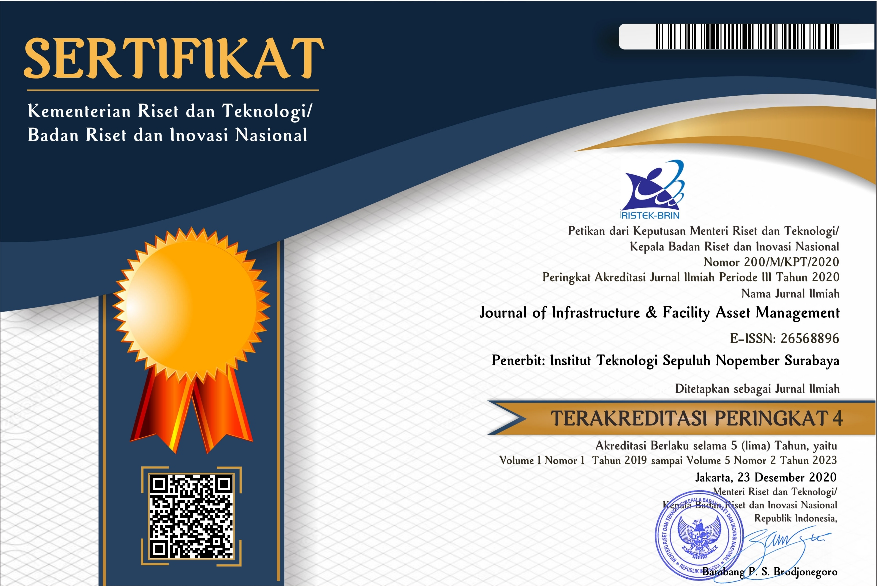Determination of the Percentage Ca(OH)2 Lime Stabilization Material for Weathered Clay Shale as Road Subgrade on Serang – Panimbang Toll Road Section III STA 57+200
Abstract
Clay shale consists of thin, layered formations with irregular fractions, highly smooth, and easily separable along the layer planes. If Clay shale is exposed to sunlight, air, and water for a relatively short period, it will undergo weathering. The construction of the Serang - Panimbang Toll Road Section III is carried out by cutting the soil according to the planned contours. After the cutting process, the subgrade material undergoes a change in its characteristic properties and mechanics because the subgrade soil is Clay shale material that has weathered, commonly referred to as "Weathered Clay Shale." To transform this soil into a subgrade layer that meets the requirements, stabilization with Ca(OH)2 lime is necessary; in this case, the percentage of lime and the duration of curing need to be determined to achieve optimum lime content.
The soil material used is Weathered Clay Shale obtained from the Serang - Panimbang Toll Road Section III STA 57+200. The research involves identifying the initial soil properties, conducting standard proctor tests on soil mixtures with lime variations of 4%, 7%, and 10% to determine the most optimum soil-lime mixture with Ca(OH)2. Subsequently, soil properties are identified with the most optimum lime mixture, and soaked CBR tests are conducted on the optimum lime-soil mixture with curing time variations of 0, 7, and 14 days.
The 7% Ca(OH)2 lime mixture with weathered clay shale soil at STA 57+200 in the construction of the Serang-Panimbang Toll Road Section III has achieved sufficiently good bearing strength. The bearing capacity attained has exceeded the requirements of the Bina Marga Specifications Revision II, especially during the 14-day curing period, where the achieved bearing capacity significantly surpasses the specified standards.
Full Text:
PDFReferences
Ariesnawan, Rizka Adi., Soemitro, RAA., & Warnana, Dwa D. (2015a). Karakteristik Mekanik Dan Dinamik Clay Shale Kabupaten Tuban Terhadap Perubahan Kadar Air. Institut Teknologi Sepuluh Nopember, Surabaya.
Firmansyah, Yerry K., Soemitro, RAA., Warnana, Dwa D., & Ekaputri, Januarti J. (2021a). Cracked Soil Behaviour Treated with Geopolymer for River Embankment Using A Fuzzy C-Means Method. Institut Teknologi Sepuluh Nopember, Surabaya.
Harnaeni, Senja Rum. (2013a). Tinjauan Parameter Kuat Geser Lempung Yang Distabilisasi Dengan Kapur. Seminar Nasional III Teknik Sipil 2013. Universitas Muhammadiyah Surakarta.
Hotineanu, Anca., Bouasker, Marwen., Aldaood, Abdulrahman., & Al-Mukhtar, Muzahim. (2014a). Effect of Freeze-Thaw Cycling on the Mechanical properties of Lime-Stabilized Expansive Clays. ScienceDirect: Cold Regions Science and Technology 119 (2015) 151-157.
Hutagamissufardal I.B. Mochtar & Noor Endah B. Mochtar. (2018). The Effect of Cracks Propagation on Cohesion and Internal Friction Angle for High Plasticity Clay. Institut Teknologi Sepuluh Nopember, Surabaya.
Irdiana, Rossa., Mochtar, I.B., & Mochtar, Noor Endah B. (2021a). Korelasi Parameter Fisis Tanah Dengan Kekuatan Geser Tanah Menggunakan Modifikasi Alat Uji Geser Langsung (Modified Direct Shear) Pada Cracked Soil. Institut Teknologi Sepuluh Nopember, Surabaya.
Limbong, Muhammad Novratama. (2023). Studi Pengaruh Proses Pengeringan terhadap Keretakan Tanah Lempung Bobonaro dan Penanganan dengan Stabilisasi Kapur Ca(OH)2, Tesis, Pascasarjana ITS, Surabaya.
Liu, Chun., Tang, Chao-Sheng., Shi, Bin., & Suo, Wen-Bin. (2013a). Automatic quantification of crack patterns by image processing. Elsevier-Journal, Computers & Geosciences 57 (2013) 77–80.
Nurdin, Sukiman., & Ahmad, Sulaiman. H. (2017a). Effect Of Fiber On Degree Of Density and Crack Intensity Factor On Wet Dry Cycle. INFRASTRUKTUR Vol. 7 No. 1, Juni 2017: 38 – 50.
Rokman, Abdul., &Artiani, Gita P. (2015a). “Perbaikan Sifat Fisik Tanah Bekas Timbunan Sampah Dengan Bahan Stabilisasi Kapur”. Website: jurnal.ftumj.ac.id/index.php/ semnastek, Sekolah Tinggi Teknik-PLN, Jakarta.
Satrya, TR., Soemitro, RAA., Maulana, MA., Warnana, DD., & Soetanto, R. (2019). Assessment of Infrastructure Assets Induced by Water Level Fluctuation along the Bengawan Solo River.
Satrya, Trihanyndio Rendy, Soemitro, RAA., & Mukunoki, Toshifumi. (2017a). Change of Soil Properties in the Bengawan Solo River Embankment due to Drying-Wetting Cycles. Geotechnical Engineering Journal of the SEAGS & AGSSEA Vol. 48 No. 4 December 2017 ISSN 0046-5828. Institut Teknologi Sepuluh Nopember, Surabaya, Indonesia.
Soehardi, Fitridawati, Lubis, Fadrizal., & Dwi Putri, Lusi. (2017a). Stabilisasi Tanah Dengan Variasi Penambahan Kapur Dan Waktu Pemeraman. Prosiding Konferensi Nasional Teknik Sipil dan Perencanaan (KN-TSP) 2017, Universitas Lancang Kuning, Pekanbaru.
Soemitro,RAA., Suprayitno, Hitapriya. (2020). Preliminary on Basic Principle of Operation Management for Public Work Infrastructure Asset Management.
Suprayitno, Hitapriya., Soemitro,RAA. (2018). Preliminary Reflexion on Basic Principle of Infrastructure Asset Management.
Widayanti, Ari., Soemitro, RAA., Ekaputri, Januarti J., & Suprayitno, Hitapriya. (2019). Gradation Analysis of Reclaimed Aphalt Pavement from National Road as Asphalt Concrete Layer
DOI: http://dx.doi.org/10.12962%2Fjifam.v6i1.19891
Refbacks
- There are currently no refbacks.
Visitor :
Flag Counter

Journal Of Infrastructure & Facility Asset Management by Institut Teknologi Sepuluh Nopember is licensed under a Creative Commons Attribution-ShareAlike 4.0 International License.





